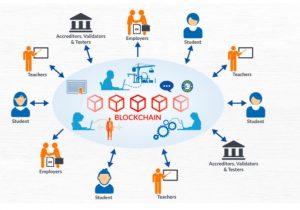What is blockchain?
Let’s imagine a ledger used for storing transactional information or shared data between millions of computers or connected devices. Blockchain works at the same way as ledger, and furthermore it records the information and data in the way that makes it impossible to change, hack, or cheat the system.
How blockchain works?
When a new transaction in blockchain is made (send or receive money), it will be automatically added to a “block”, then put into “chain”.
For example, when it comes a transaction, this information will broadcast to the computers of the peer-to-peer network, and then it will be validated. After that, it is added to a block together with other transactions. This block is then hashed and the new block is permanently added to the blockchain and distributed to all its participants. The transaction is completed.
What is the feature of blockchain?
‘Secure’, ‘Decentralized’ and ‘Without third-party’ are what make Blockchain technology becomes revolutionary.
Above is some basic information about blockchain. For those who are new to blockchain technology, there are still some confusing points about this technology and in this article we would like to share with you 3 things that you may be misunderstood about BLOCKCHAIN.
No 1. Blockchain and bitcoin are not the same thing.
When hearing about blockchain, some people believe that it is bitcoin because they are quite closed related, but it is a big misconception.
Bitcoin is a virtual currency (or cryptocurrency), while blockchain is the tool that makes virtual currency viable. Otherwise speaking, Bitcoin is the best-known use case for blockchain.
Bitcoin or Litecoin belongs to Public Blockchain (1 out of 4 blockchain types). Anyone can participate in reading/writing/auditing the blockchain and no one is in charge. In addition, these types of blockchain are open and transparent, therefore anyone can review anything at a given point of time on a public blockchain.
No 2. Blockchain goes beyond the finance.
Nowadays, but while blockchain is widely used in financial systems for storing transaction transparently and reliably, there are many others besides.
For example, blockchain allows musicians to get paid directly when consumers buy or listen to a song. The purchasing platforms can be cut out of the process, which also means they don’t take a cut of the revenue. Musicians benefit both financially and from a more direct relationship with their fans.
Another example is online voting. When a vote is cast and recorded in the blockchain, it is very hard to alter. That makes it difficult to commit voter fraud by manipulating votes. Furthermore, every voter would have a complete record at hand and could track the outcome as the vote takes place.
Moreover, this technology continues to expand for other fields such as health data, shipping, power plant data, etc, and will be an increasingly important technology going forward.
No.3 Data in a Blockchain is public?
There is a misunderstanding that Blockchain is always publicly accessible to everyone. This misconception come from the idea of bitcoin, which is public to the worldwide community.
But in fact, cryptocurrency is merely a way blockchain can work. Besides being public, blockchain can be private or hybrid. What type of blockchain to use is based on its purposes.
For example, A public chain is suitable for a truly democratized and authority-free organization that encourages as many participants as possible. In reverse, a private blockchain is preferred by businesses in logistics, finances, healthcare, etc., to enhance efficiency and immutability. Members can only join the network through an invitation. Meanwhile, Hybrid lies in between public and private blockchains. Anyone cannot participate in the network unless they meet a strict identity verification process. Among those members, only some give designated permissions.
Source:
Blockchain: 10 things you need to know – Bosch ConnectedWorld Blog (bosch-si.com)


